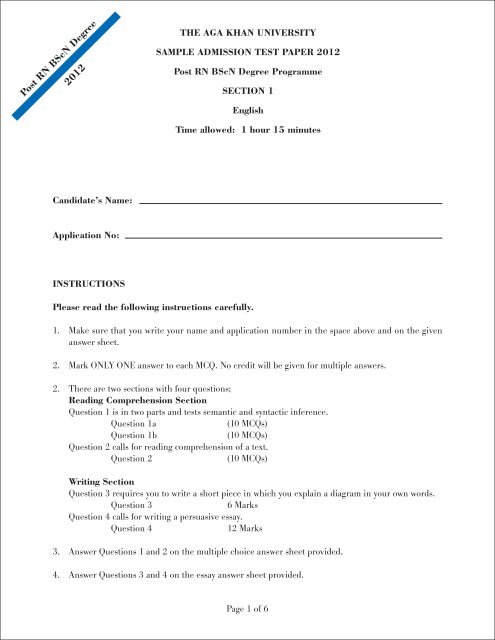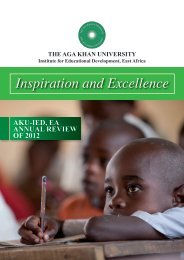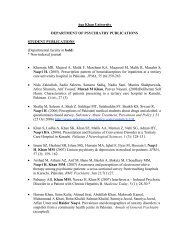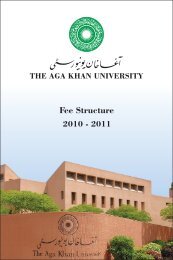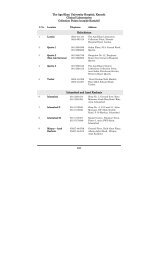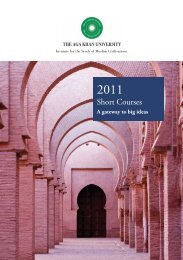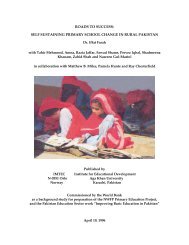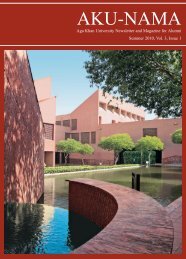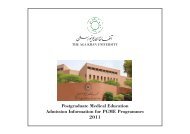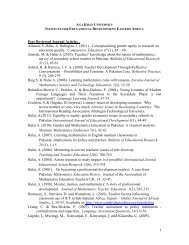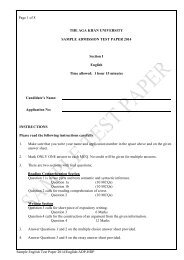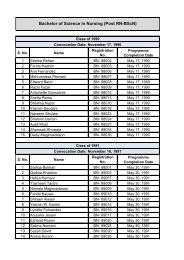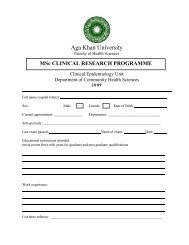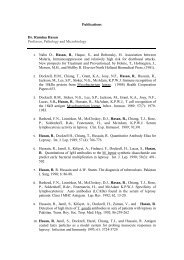Test Paper.FH10 - Aga Khan University
Test Paper.FH10 - Aga Khan University
Test Paper.FH10 - Aga Khan University
Create successful ePaper yourself
Turn your PDF publications into a flip-book with our unique Google optimized e-Paper software.
Post RN BScN Degree<br />
2012<br />
Candidate’s Name:<br />
Application No:<br />
INSTRUCTIONS<br />
THE AGA KHAN UNIVERSITY<br />
SAMPLE ADMISSION TEST PAPER 2012<br />
Post RN BScN Degree Programme<br />
SECTION 1<br />
English<br />
Time allowed: 1 hour 15 minutes<br />
Please read the following instructions carefully.<br />
1. Make sure that you write your name and application number in the space above and on the given<br />
answer sheet.<br />
2. Mark ONLY ONE answer to each MCQ. No credit will be given for multiple answers.<br />
2. There are two sections with four questions;<br />
Reading Comprehension Section<br />
Question 1 is in two parts and tests semantic and syntactic inference.<br />
Question 1a (10 MCQs)<br />
Question 1b (10 MCQs)<br />
Question 2 calls for reading comprehension of a text.<br />
Question 2 (10 MCQs)<br />
Writing Section<br />
Question 3 requires you to write a short piece in which you explain a diagram in your own words.<br />
Question 3 6 Marks<br />
Question 4 calls for writing a persuasive essay.<br />
Question 4 12 Marks<br />
3. Answer Questions 1 and 2 on the multiple choice answer sheet provided.<br />
4. Answer Questions 3 and 4 on the essay answer sheet provided.<br />
Page 1 of 6
Question 1 has two parts with a total of 20 items. In both parts, you are given a passage with numbered<br />
gaps. For each numbered gap, choose the best answer A, B, C, or D from the choices given. In the test<br />
itself you must remember to record your answers on the Answer sheet provided.<br />
Here is an example of the type of passage you will find in both parts of Question 1:<br />
Q.1. (Total 20 Marks)<br />
This section has two reading passages. Each passage is followed by ten multiple choice questions.<br />
Read the following passage carefully. For each numbered gap in the text choose the best answer from<br />
the possible choices (A, B, C, or D) given. Remember to record your answers on the Answer sheet<br />
provided. Do NOT write in this booklet.<br />
Passage<br />
Public and Private Primary Education in Pakistan<br />
A recent World Bank report calls for a re-evaluation of education polices in the context of a dramatic<br />
increase in the number of private schools in primary education in Pakistan. The report says that the<br />
quality of education at public schools …..(1)……., and children at private schools score significantly higher<br />
than those at public schools, …….(2)……… from the same village.<br />
The World Bank report presents facts and figures from a comprehensive survey of public and private<br />
schools in 112 villages in Pakistan, and lays out important policy options to facilitate evidence-based<br />
policy making.<br />
For-profit private schools have become …..(3).….. in both urban and rural areas and they provide parents<br />
with an alternative option ……(4)……. their children's education, the report says.<br />
1. A. was lacked<br />
B. is lacking<br />
C. lacks<br />
D. has been lacking<br />
A<br />
B C D<br />
2. A. even as those who are<br />
B. even though the schools are<br />
C. even they are<br />
D. even if they are<br />
A<br />
B C D<br />
Page 2 of 6<br />
3. A. a widespread presence<br />
B. an unrealistic alternative<br />
C. realistic enigmas<br />
D. a sadly restricted option<br />
A<br />
B C D<br />
4. A. to invest<br />
B. to invest for<br />
C. for investing in<br />
D. by the investment of<br />
A<br />
B C D
Question 2 asks you to read the given passage carefully and then answer the ten multiple choice questions<br />
which follow. Here is an example:<br />
Q.2. (Total 10 Marks)<br />
You are asked to read the given passage carefully and then answer the ten multiple choice questions which<br />
follow. Choose the best answer A, B, C or D for each question. Remember to record your answers<br />
on the Answer sheet provided. Do NOT write in this booklet.<br />
The Romans<br />
The Romans for centuries the masters of war and politics across Europe, Northern Africa, and Asia<br />
Minor – have often been criticized for producing few original thinkers outside the realm of politics.<br />
This criticism, while in many ways true, is not without its problems. It was, after all, the conquest<br />
of Greece that provided Rome with its greatest influx of educated subjects. Two of the great disasters<br />
5 in intellectual history – the murder of Archimedes and the burning of Alexandria’s Library – both<br />
occurred under Rome’s watch. Nevertheless, a city that was able to conquer so much of the<br />
known world could not have been devoid of the creativity that characterizes so many other ancient<br />
empires.<br />
Engineering is one endeavour in which the Romans showed themselves capable. Their aqueducts<br />
10 carried water hundreds of miles along the tops of vast arcades. Roman roads built for the rapid<br />
deployment of troops, criss-cross Europe and still form the basis of numerous modern highways that<br />
provide quick access between many major European and African cities. Indeed, a large number of<br />
these cities owe their prominence to Rome’s economic and political influence.<br />
Many of these major cities lie far beyond Rome’s original province; Latin-derived languages are spoken<br />
15 in most Southern European nations. <strong>Aga</strong>in a result of military influence, the popularity of Latin and<br />
its offspring is difficult to overestimate. During the centuries of ignorance and violence that followed<br />
Rome’s decline, the Latin language was the glue that held together the identity of an entire continent.<br />
While seldom spoken today, it is still studied widely, if only so that such a master of rhetoric as Cicero<br />
can be read in the original.<br />
20 It is Cicero and his like who are perhaps the most overlooked legacy of Rome. While far from being<br />
a democracy, Rome did leave behind useful political tools that serve the American republic today.<br />
“Republic”, itself Latin for “the people’s business,” is a notion cherished in democracies worldwide.<br />
Senators owe their name to Rome’s class of elders; Representatives owe theirs to the Tribunes who<br />
seized popular prerogatives from the Senatorial class. The veto was a Roman notion adopted by the<br />
25 historically aware framers of the Constitution, who often assumed pen names from the lexicon of<br />
Latin life. These accomplishments, as monumental as any highway or Coliseum, will remain prominent<br />
features of the Western landscape.<br />
The legacy of the Romans is extremely important. Many things that form part of everyday life were<br />
introduced or improved by the Romans. Over the centuries since the collapse of the Roman Empire,<br />
30 Roman ideas, literature, art and architecture have influenced many people around the world.<br />
Page 3 of 6
5. The author describes “two of the great disasters in intellectual history” in order to<br />
A. establish a point directly related to the criticism.<br />
B. show that certain historical claims are inaccurate.<br />
C. counter the charge of anti-intellectualism.<br />
D. demonstrate the importance of certain historical data.<br />
A<br />
6. According to the given extracts, ancient Roman roads<br />
A. are engineering marvels unequalled in modern times.<br />
B. connected many major cities in ancient Europe.<br />
C. are similar in some respects to modern highways.<br />
D. were products of democratic political institutions.<br />
A<br />
7. According to the given passage, which of the following accurately describes the Latin language?<br />
I. It spread in part due to Rome’s military power<br />
II. It is reflected in modern political concepts<br />
III. It is spoken today in some parts of Europe<br />
A. I only<br />
B. II only<br />
C. I and II only<br />
D. I and III only<br />
A<br />
B C D<br />
B C D<br />
B C D<br />
8. It can be inferred from the extracts that the framers of the American Constitution<br />
A. overlooked Cicero’s contribution to the theory of democracy.<br />
B. formed a government based on world-wide democracy.<br />
C. embraced the veto as a hallmark of Roman democracy.<br />
D. were familiar with certain aspects of Roman government.<br />
A<br />
B C D<br />
Page 4 of 6
Question 3 asks you to use the given diagram and the text to explain a process such as the order of events<br />
or how something works. Here is an example:<br />
Diagrammatic Explanation<br />
Q.3. (Total 6 Marks)<br />
The diagram below shows an early bicycle before the bicycle chain was invented.Ê Write a paragraph or<br />
two explaining how this bicycle worked, drawing attention to its advantages and disadvantages as a method<br />
of travel. Remember to use only the separate essay answer sheet provided.<br />
1.) Saddle<br />
2.) Saddle Spring<br />
3.) Frame<br />
4.) Crank Arm<br />
5.) Pedal<br />
6.) Rim<br />
7.) Hub<br />
8.) Tire<br />
9.) Front Fork<br />
10.) Spoon Brake<br />
11.) Handle Bar<br />
Page 5 of 6<br />
Reference: DaileyGreenspunProject1.svg<br />
Question 4 gives you some information on a particular issue followed by a statement. You are asked to<br />
write a persuasive essay supporting the statement. Use of your own words in the persuasive essay will<br />
be rewarded by the examiners. Here is an example:<br />
Persuasive Essay<br />
Q.4. (Total 12 Marks)<br />
Directions<br />
Using the opinion expressed below, write a persuasive essay supporting the statement. Try to express<br />
your ideas in your own words. Credit will not be given for copying your answer directly from the given<br />
statement. Remember to use only the separate essay answer sheet provided.<br />
FOR EXAMPLE:<br />
'The brain drain is a major human resource issue in developing countries. Write an essay<br />
persuading young people to stay in their own country in order to contribute to its development<br />
and progress'.
Choose the correct answer.<br />
Example<br />
Q. A client is receiving whole blood when she starts to shake with chills; her temperature is 101 degree<br />
Fahrenheit. The nurse should first:<br />
A. Call the physician immediately<br />
B. Administer the PRN dose of Aspirin<br />
C. Start another IV, running normal saline<br />
D. Stop the blood immediately<br />
A<br />
Q. Which nursing action is essential to prevent hypoxemia during tracheal suctioning?<br />
A. Removing oral and nasal secretions<br />
B. Encouraging the patient to deep breathe and cough<br />
C. Administering 100% oxygen<br />
D. Auscultating the lungs to determine the baseline data<br />
A<br />
Q. A 72-year-old client was admitted for lung biopsy to rule out cancer. In order to facilitate the<br />
endotracheal intubation, the physician ordered succinylcholine (Anectine) 25mg IV slowly. Using a<br />
20mg/ml, how many ml did the nurse administer?<br />
A. 0.5ml<br />
B. 1.0ml<br />
C. 1.25ml<br />
D. 1.50ml<br />
A<br />
B C D<br />
B C D<br />
B C D<br />
THE AGA KHAN UNIVERSITY<br />
SAMPLE ADMISSION TEST PAPER 2012<br />
Post RN BScN Degree Programme<br />
SECTION 1I<br />
Nursing Knowledge<br />
Page 6 of 6


